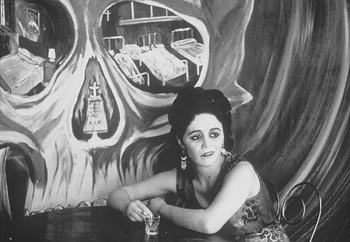![[Metroactive Arts]](/arts/gifs/art468.gif)
[ Arts Index | Metro | Metroactive Central | Archives ]
A Hybrid Reality
 Spirit in the Image: 'Mexico City,' a 1972 gelatin silver print, demonstrates Graciela Iturbide's ability to elicit a lifetime of meaning in her portraits. Graciela Iturbide's photographs of Mexico are a shared exploration with her subjects By Ann Elliott Sherman OTHERS HAVE photographed Mexican villagers wrapped in colorful clothes, selling their wares in the marketplace, but how often have the people in those travelogue images held the lens equally captive by their gaze? If, along with the body's ghosted image, part of the soul is captured on film, what is given in return? When the photographer is Graciela Iturbide, whose works are now on the display at the San Jose Museum of Art, the answers are interwoven. Though she travels through Mexico and photographs both day-to-day life and annual rituals, Iturbide creates pictures that are not a folkloric inventory but a shared exploration, a dialogue between artist and subject. And that is her reciprocation: the respectful acknowledgment of an essential collaboration, a call and response. What answers the camera is not stolen away, but given; the subject's inherent dignity is not only intact, but magnified. To achieve this "complicity," Iturbide avoids the blitzkrieg approach to a photo shoot. Arriving in a town, she introduces herself, announces that she is going to stay for a while to photograph their traditions, and lives with them in their homes. This blurring of the boundary between insider and outsider begins Iturbide's exploration of the interstices and those most often relegated to them--women, children, the old. The revelation of what is held dear, talismans, work and how it is performed; earthbound angels, the borderlands between the living and the dead shrouded in mist, birds--in all these Iturbide searches for the flint and friction that frees the spark, the arcing connections, the juice, and transforms a static medium into poetry of the flux and flow of life. In a country that has known repeated cultural clashes--between matriarchal and patriarchal indigenous peoples, native belief and colonizing Spanish Catholicism, traditional rural life and modern influences--negotiating the collisions and divides is the real national pastime, an ongoing, mercurial process of cultural amalgamation and resistance. Witnessing the hybrid reality of Mexico, unlocking the alchemy of people, time and place has become Iturbide's quest as a seeker belonging everywhere and nowhere. Who better to see the rightness of a reveler pushing aside a traditional mask to front a TV wrestler's spandex hood--and pose in a skirt over trousers in the old Mexican studio style (Jano)? Or to receive "like a gift life gave me" the image of a Seri Indian woman with flowing, windblown hair and long skirts, poised on a rocky precipice as if to take flight into the desert, boombox in hand (Mujer ángel)? As in Mexican culture, a constant theme in Iturbide's work is the interplay of celebration and death. Her own signature spin on this is the image of the death bride, repeatedly cropping up at carnivals, first communions and parades. It's a particularly female expression of duality, a manifestation of knowledge not only consciously held, but often physically realized: the end of one life wed to another's beginning. THE STRENGTH of female community is apparent in Iturbide's series focusing on the uniquely autonomous women of Juchitán or the cholas of East Los Angeles. These works celebrate pockets of triumph over constraints of the larger culture. Iturbide's tender portraits of the cross-dresser Magnolia reveal that not only women enjoy a greater breadth and fluidity of gender roles in the Zapotec town. Goya's painting Maja and Celestina on a Balcony posits a charming young whore and the gloating crone who stables her as the bait and the hook of a male viewer's seduction. Using a similar juxtaposition, Iturbide inverts the viewpoint in Quince años. Dressed in a virginal gown, coiffed and bejeweled for her coming-of-age party, the lovely 15-year-old soberly regards the viewer as she literally and figuratively stands on the threshold. On the other side of the portal sits an old abuela, as relaxed in posture and dress as the girl is formal. Either lost in reverie or merely indifferent to the camera, she's the flip side of aging, both its ravages and its privilege. Rather than a man's view of woman as an alluring/threatening other, this is a woman's internal confrontation with what writer Alfredo López Austin calls "we-are-other." The photo puts the female viewer in the middle; having looked, we can't escape recognition of our once and future fate. Iturbide's images are postcards from the realm of ambiguity and duality, where the serpent of the past wraps around the present and nips the tail of the future. Their revelation of ongoing transformations necessarily instills a kind of heightened awareness and wonder. Just like the rituals and festivals Iturbide photographs, her works pierce an opening in the veil of familiarity that brings always present, conveniently ignored complexities to light.
Images of the Spirit: Photographs by Graciela Iturbide runs through April 4 at the San Jose Museum of Art, 110 S. Market St., San Jose. (408/271-6840) [ San Jose | Metroactive Central | Archives ]
|
From the March 11-17, 1999 issue of Metro.
Copyright © Metro Publishing Inc. Maintained by Boulevards New Media.